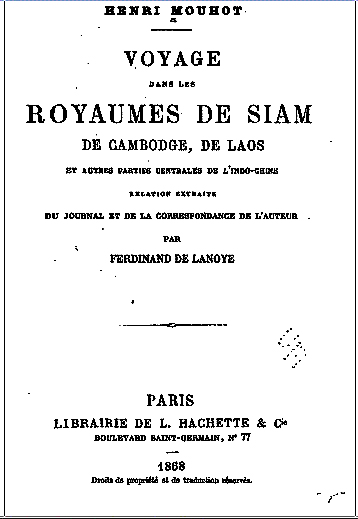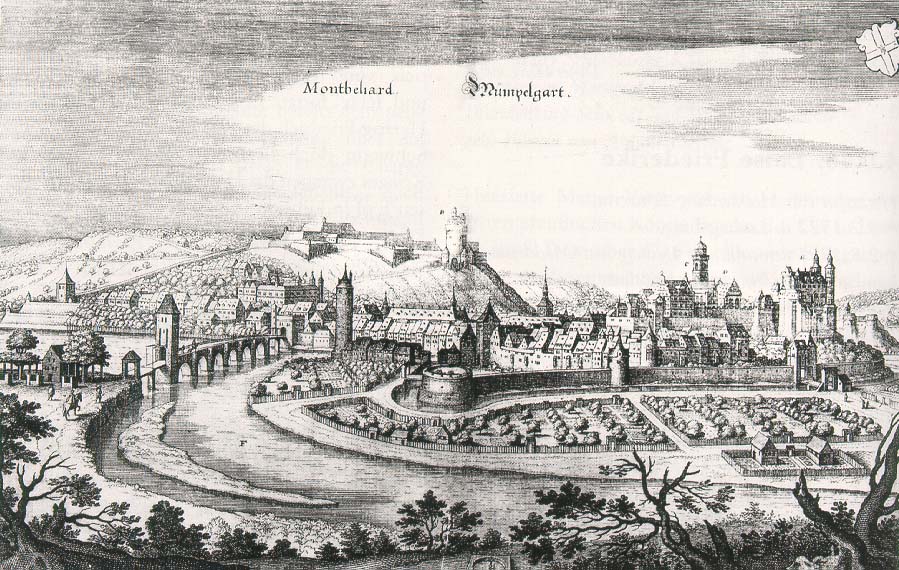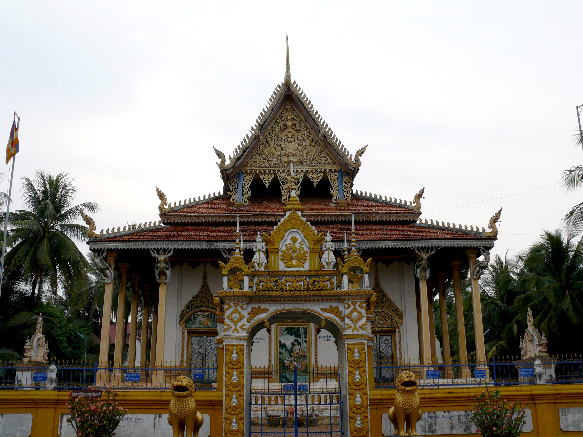|
Henri Mouhot
Alexandre Henri Mouhot (May 15, 1826 — November 10, 1861) was a French naturalist and explorer of the mid-19th century. He was born in MontbĂ©liard, Doubs, France, near the Swiss border, but spent his childhood in Russia and, possibly, parts of Asia. He died near Naphan, Laos. He is remembered mostly in connection to Angkor. Mouhot's tomb is located just outside of Ban Phanom, to the east of Luang Prabang. Early life He traveled throughout Europe with his brother Charles, studying photographic techniques developed by Louis Daguerre. In 1856, he began devoting himself to the study of Natural Science. Upon reading "The Kingdom and People of Siam" by Sir John Bowring in 1857, Mouhot decided to travel to Indochina to conduct a series of botanical expeditions for the collection of new zoological specimens. His initial requests for grants and passage were rejected by French companies and the government of Napoleon III. The Royal Geographical Society and the Zoological Society of ... [...More Info...] [...Related Items...] OR: [Wikipedia] [Google] [Baidu] |
Montbéliard
Montbéliard (; traditional ) is a town in the Doubs department in the Bourgogne-Franche-Comté region in eastern France, about from the border with Switzerland. It is one of the two subprefectures of the department. History Montbéliard is mentioned as early as 983 as . The County of Montbéliard or Mömpelgard was a feudal county of the Holy Roman Empire from 1033 to 1796. In 1283, it was granted rights under charter by Count Reginald. Its charter guaranteed the county perpetual liberties and franchises which lasted until the French Revolution in 1789. Montbéliard's original municipal institutions included the Magistracy of the Nine Bourgeois, the Corp of the Eighteen and the Notables, a Mayor, and Procurator, and appointed "Chazes", all who participated in the administration of the county as provided by the charter. Also under the 1283 charter, the Count and the people of Montbéliard were required by law to defend Montbéliard, while citizens of Montbéliard were not ... [...More Info...] [...Related Items...] OR: [Wikipedia] [Google] [Baidu] |
Cambodia
Cambodia (; also Kampuchea ; km, ááááá»áá¶, UNGEGN: ), officially the Kingdom of Cambodia, is a country located in the southern portion of the Indochinese Peninsula in Southeast Asia, spanning an area of , bordered by Thailand to the northwest, Laos to the north, Vietnam to the east, and the Gulf of Thailand to the southwest. The capital and largest city is Phnom Penh. The sovereign state of Cambodia has a population of over 17 million. Buddhism is enshrined in the constitution as the official state religion, and is practised by more than 97% of the population. Cambodia's minority groups include Vietnamese, Chinese, Chams and 30 hill tribes. Cambodia has a tropical monsoon climate of two seasons, and the country is made up of a central floodplain around the TonlĂ© Sap lake and Mekong Delta, surrounded by mountainous regions. The capital and largest city is Phnom Penh, the political, economic and cultural centre of Cambodia. The kingdom is an e ... [...More Info...] [...Related Items...] OR: [Wikipedia] [Google] [Baidu] |
Michelangelo
Michelangelo di Lodovico Buonarroti Simoni (; 6 March 1475 â 18 February 1564), known as Michelangelo (), was an Italian sculptor, painter, architect, and poet of the High Renaissance. Born in the Republic of Florence, his work was inspired by models from classical antiquity and had a lasting influence on Western art. Michelangelo's creative abilities and mastery in a range of artistic arenas define him as an archetypal Renaissance man, along with his rival and elder contemporary, Leonardo da Vinci. Given the sheer volume of surviving correspondence, sketches, and reminiscences, Michelangelo is one of the best-documented artists of the 16th century. He was lauded by contemporary biographers as the most accomplished artist of his era. Michelangelo achieved fame early; two of his best-known works, the ''PietĂ '' and ''David'', were sculpted before the age of thirty. Although he did not consider himself a painter, Michelangelo created two of the most influential frescoe ... [...More Info...] [...Related Items...] OR: [Wikipedia] [Google] [Baidu] |
King Solomon
King is the title given to a male monarch in a variety of contexts. The female equivalent is queen, which title is also given to the consort of a king. *In the context of prehistory, antiquity and contemporary indigenous peoples, the title may refer to tribal kingship. Germanic kingship is cognate with Indo-European traditions of tribal rulership (c.f. Indic '' rÄjan'', Gothic '' reiks'', and Old Irish '' rĂ'', etc.). *In the context of classical antiquity, king may translate in Latin as '' rex'' and in Greek as ''archon'' or '' basileus''. *In classical European feudalism, the title of ''king'' as the ruler of a ''kingdom'' is understood to be the highest rank in the feudal order, potentially subject, at least nominally, only to an emperor (harking back to the client kings of the Roman Republic and Roman Empire). *In a modern context, the title may refer to the ruler of one of a number of modern monarchies (either absolute or constitutional). The title of ''king'' is ... [...More Info...] [...Related Items...] OR: [Wikipedia] [Google] [Baidu] |
Angkor Thom
Angkor Thom ( km, áąáááááá ; meaning "Great City"), alternatively Nokor Thom ( km, ááááá ) located in present-day Cambodia, was the last and most enduring capital city of the Khmer Empire. It was established in the late twelfth century by King Jayavarman VII.Higham, C., 2014, Early Mainland Southeast Asia, Bangkok: River Books Co., Ltd., It covers an area of 9 kmÂČ, within which are located several monuments from earlier eras as well as those established by Jayavarman and his successors. At the centre of the city is Jayavarman's state temple, the Bayon, with the other major sites clustered around the Victory Square immediately to the north. The site is one of the major tourist attractions of southeast Asia. Etymology Angkor Thom ( km, áąáááááá) is the transform name from another alternative name of Nokor Thom ( km, ááááá), which is believed to be the correct one, due to neglect of calling it in incorrect pronunciation. The word ... [...More Info...] [...Related Items...] OR: [Wikipedia] [Google] [Baidu] |
Antonio Da Magdalena
Antonio is a masculine given name of Etruscan origin deriving from the root name Antonius. It is a common name among Romance language-speaking populations as well as the Balkans and Lusophone Africa. It has been among the top 400 most popular male baby names in the United States since the late 19th century and has been among the top 200 since the mid 20th century. In the English language it is translated as Anthony, and has some female derivatives: Antonia, AntĂłnia, Antonieta, Antonietta, and Antonella'. It also has some male derivatives, such as Anthonio, AntĂłn, AntĂČ, Antonis, Antoñito, Antonino, Antonello, Tonio, Tono, Toño, ToñĂn, Tonino, Nantonio, Ninni, TotĂČ, TĂł, Tonini, Tony, Toni, Toninho, Toñito, and TĂ”nis. The Portuguese equivalent is AntĂłnio (Portuguese orthography) or AntĂŽnio (Brazilian Portuguese). In old Portuguese the form AntĂŁo was also used, not just to differentiate between older and younger but also between more and less important. In Gali ... [...More Info...] [...Related Items...] OR: [Wikipedia] [Google] [Baidu] |
Khmer People
The Khmer people ( km, áááá¶áá·ááááá, ) are a Southeast Asian ethnic group native to Cambodia. They comprise over 90% of Cambodia's population of 17 million.Cambodia CIA World FactBook. They speak the , which is part of the larger Austroasiatic-language family found in parts of (including , |
Battambang
Battambang ( km, áá¶áááááá, UNGEGN: ) is the capital of Battambang Province and the third largest city in Cambodia. Founded in the 11th century by the Khmer Empire, Battambang is the leading rice-producing province of the country. For nearly 100 years it was a major commercial hub and provincial capital of Siamese province of Inner Cambodia (1795-1907), though it was always populated by Khmer, with some ethnic Vietnamese, Lao, Thai and Chinese. Battambang remains the hub of Cambodia's northwest, connecting the region with Phnom Penh and Thailand. The city is situated on the Sangkae River, a tranquil, small body of water that winds its way picturesquely through Battambang Province. As with much of Cambodia, French Colonial architecture is a notable aspect of the city, with some of the best-preserved examples in the country. Now the government and Ministry of Culture and Fine Art are preparing documents to nominate The Old Town of Battambang in the list of UNES ... [...More Info...] [...Related Items...] OR: [Wikipedia] [Google] [Baidu] |
Charles Emile Bouillevaux
Charles is a masculine given name predominantly found in English and French speaking countries. It is from the French form ''Charles'' of the Proto-Germanic name (in runic alphabet) or ''*karilaz'' (in Latin alphabet), whose meaning was "free man". The Old English descendant of this word was '' Äearl'' or ''Äeorl'', as the name of King Cearl of Mercia, that disappeared after the Norman conquest of England. The name was notably borne by Charlemagne (Charles the Great), and was at the time Latinized as ''Karolus'' (as in ''Vita Karoli Magni''), later also as '' Carolus''. Some Germanic languages, for example Dutch and German, have retained the word in two separate senses. In the particular case of Dutch, ''Karel'' refers to the given name, whereas the noun ''kerel'' means "a bloke, fellow, man". Etymology The name's etymology is a Common Germanic noun ''*karilaz'' meaning "free man", which survives in English as churl (< Old English ''Äeorl''), which developed its d ... [...More Info...] [...Related Items...] OR: [Wikipedia] [Google] [Baidu] |
Pavillion Of Angkor Wat
In architecture, ''pavilion'' has several meanings: * It may be a subsidiary building that is either positioned separately or as an attachment to a main building. Often it is associated with pleasure. In palaces and traditional mansions of Asia, there may be pavilions that are either freestanding or connected by covered walkways, as in the Forbidden City ( Chinese pavilions), Topkapi Palace in Istanbul, and in Mughal buildings like the Red Fort. * As part of a large palace, pavilions may be symmetrically placed building ''blocks'' that flank (appear to join) a main building block or the outer ends of wings extending from both sides of a central building block, the ''corps de logis''. Such configurations provide an emphatic visual termination to the composition of a large building, akin to bookends. The word is from French (Old French ) and it meant a small palace, from Latin (accusative of ). In Late Latin and Old French, it meant both âbutterflyâ and âtentâ, becaus ... [...More Info...] [...Related Items...] OR: [Wikipedia] [Google] [Baidu] |




_(6918753837).jpg)

